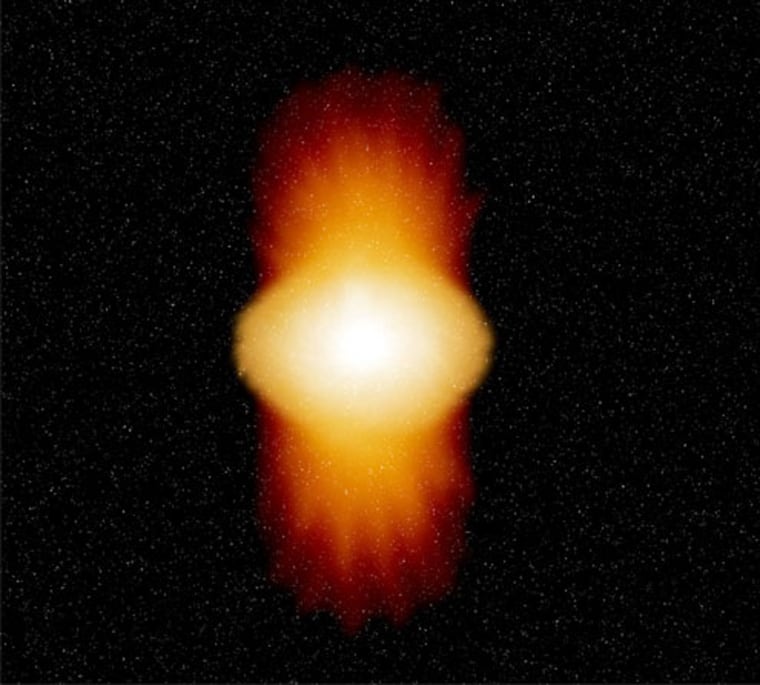If your idea of fun is whirling around on a dizzying carnival ride, astronomers have found a stellar adventure that would stop you in your tracks. A sizzling-hot star is spinning around at near break-up velocity, according to a new study.
Astronomers wonder if material will be ejected from the star, called Alpha Arae.
“Alpha Arae is very close to its breakup velocity, and the matter may freely escape the equatorial regions, 'launched' by the centrifugal force, as if you were on a crazy merry-go-round,” lead researcher Philippe Stee of the Observatory of Côte d’Azur in France, told SPACE.com.
Located about 300 light-years from Earth, Alpha Arae is the nearest "Be star"—a class of rapidly rotating stars that are very luminous, massive and hotter than the Sun. On Aug. 23, 1866, Italian astronomer Father Angelo Secchi discovered the first Be star, Gamma Cassiopeiae. Since then, the dizzying stars have continued to baffle astronomers.
Just a couple 140-year-old puzzlers: How does the ring of gas that surrounds Be stars form? And what keeps the gas disk in motion?
The new study results, which will be detailed in an upcoming issue of the journal Astronomy and Astrophysics, bring astronomers closer to answering these questions.
The need for speed
Keeping gas particles swirling together in a disk requires top speed.
“For material to be in orbit in a disk, it requires a great deal of angular momentum,” said Ken Gayley, a researcher at the University of Iowa who was not involved in the study. A source of this rotational velocity would be from the central, rotating star.
Stee and colleagues examined the Be star and its ring of gas with the European Southern Observatory’s Very Large Telescope atop a mountain in Paranal, Chile. They looked into Alpha Arae’s ring with a level of detail equivalent to distinguishing, from Earth, the headlights of a car on the moon, the astronomers said.
Prior observations of Alpha Arae indicated the star, although rapidly rotating, was not spinning fast enough to supply the required angular momentum needed to maintain a disk. One limitation had been determining the star’s tilt, or inclination angle, a key component to finding an accurate rotating speed.
“It is very difficult to know if the star is rotating slowly or if it is a fast rotator but seen nearly pole-on,” Stee explained. Using their observational data and a complicated computer model, the team calculated a true rotational velocity.
At its equator, the star is spinning at 1 million mph (470 kilometers per second) — near its break-up velocity — and speedy enough to supply the needed angular momentum to the disk.
This rapid rotation could actually fling off some of the star’s matter.
Still perplexed
The astronomers also isolated very small regions within the disk and studied each region’s velocity using the Doppler effect, a compression and expansion of radiation waves which, with sound, causes a siren to change pitch when an ambulance races toward you compared to racing away.
“For instance if the matter is flowing in your direction the emitted light is shifted to smaller wavelengths [such as blue] whereas if it is flowing away it is shifted to larger wavelengths [such as red],” Stee explained. The velocity of the disk material decreases with the square root of the distance from the star, they found.
Still, astronomers are perplexed as to what physical processes create the disk surrounding Be stars.
Many stars and even some planets flaunt a disk of gas. Astronomers have found these disks form as a result of the celestial body tugging interstellar material into orbit around itself. Depending on the density of surrounding matter, the resulting rings of gas can be either jam-packed or sparse. For Be stars, the disks are quite dense.
“Such dense disks generally only appear around stars that are forming from a region that is already a high density gas, so they draw from their environment to form disks. But Be stars have cleared out their environment so it is expected that the disk must come from the star itself, which is unusual,” Gayley said.
The high spin rate at the equator may cause material to be ejected from the star and into a swirling disk.
“Critical rotation may be the clue to the 'Be phenomenon' because we were underestimating the true stellar rotation measured by the spectroscopy,” Stee said.
Boosting the theory
Many astronomers have supported a theory that Be stars supply disk-making material but couldn’t prove the spin speed was high enough to fling off that matter. “But this requires that the underlying star be rotating 'critically'" which is the crucial finding in the Stee observation. Thus we are optimistic that this paper is a first step in a process of confirmation of this overall theoretical view,” Gayley said.
The icing on this stellar cake would be to figure out some of the finer details of this disk-forming process.
“We still don't know it the matter around this star has been flinging off by the nearly critical rotation, or if it will do it again very soon,” Stee said. And whether the star ejects material in a massive outburst or gradually with persistent loss of matter is still unknown, he said.
